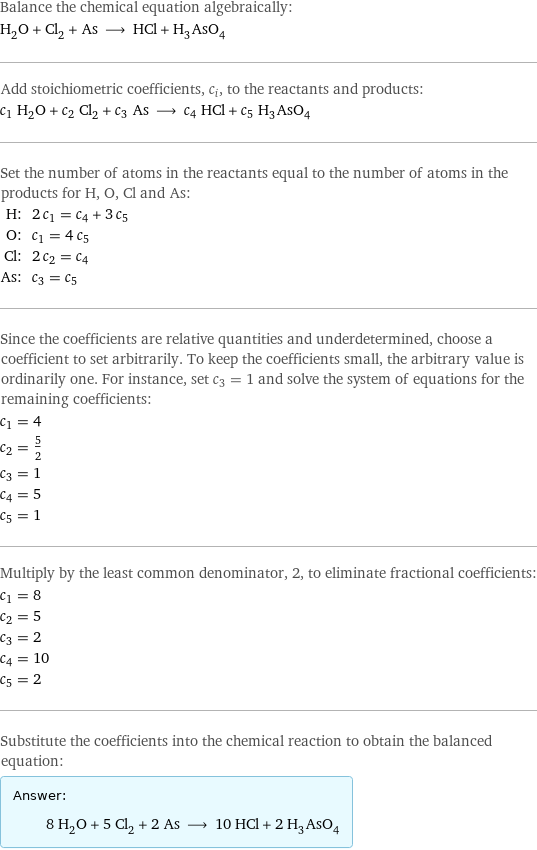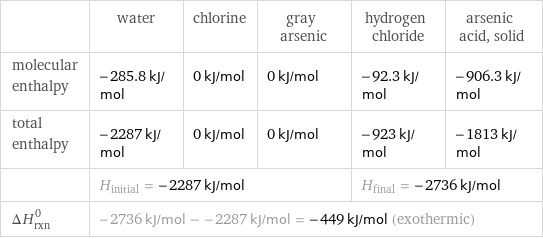Input interpretation

H_2O water + Cl_2 chlorine + As gray arsenic ⟶ HCl hydrogen chloride + H_3AsO_4 arsenic acid, solid
Balanced equation

Balance the chemical equation algebraically: H_2O + Cl_2 + As ⟶ HCl + H_3AsO_4 Add stoichiometric coefficients, c_i, to the reactants and products: c_1 H_2O + c_2 Cl_2 + c_3 As ⟶ c_4 HCl + c_5 H_3AsO_4 Set the number of atoms in the reactants equal to the number of atoms in the products for H, O, Cl and As: H: | 2 c_1 = c_4 + 3 c_5 O: | c_1 = 4 c_5 Cl: | 2 c_2 = c_4 As: | c_3 = c_5 Since the coefficients are relative quantities and underdetermined, choose a coefficient to set arbitrarily. To keep the coefficients small, the arbitrary value is ordinarily one. For instance, set c_3 = 1 and solve the system of equations for the remaining coefficients: c_1 = 4 c_2 = 5/2 c_3 = 1 c_4 = 5 c_5 = 1 Multiply by the least common denominator, 2, to eliminate fractional coefficients: c_1 = 8 c_2 = 5 c_3 = 2 c_4 = 10 c_5 = 2 Substitute the coefficients into the chemical reaction to obtain the balanced equation: Answer: | | 8 H_2O + 5 Cl_2 + 2 As ⟶ 10 HCl + 2 H_3AsO_4
Structures

+ + ⟶ +
Names

water + chlorine + gray arsenic ⟶ hydrogen chloride + arsenic acid, solid
Reaction thermodynamics
Enthalpy

| water | chlorine | gray arsenic | hydrogen chloride | arsenic acid, solid molecular enthalpy | -285.8 kJ/mol | 0 kJ/mol | 0 kJ/mol | -92.3 kJ/mol | -906.3 kJ/mol total enthalpy | -2287 kJ/mol | 0 kJ/mol | 0 kJ/mol | -923 kJ/mol | -1813 kJ/mol | H_initial = -2287 kJ/mol | | | H_final = -2736 kJ/mol | ΔH_rxn^0 | -2736 kJ/mol - -2287 kJ/mol = -449 kJ/mol (exothermic) | | | |
Equilibrium constant
![Construct the equilibrium constant, K, expression for: H_2O + Cl_2 + As ⟶ HCl + H_3AsO_4 Plan: • Balance the chemical equation. • Determine the stoichiometric numbers. • Assemble the activity expression for each chemical species. • Use the activity expressions to build the equilibrium constant expression. Write the balanced chemical equation: 8 H_2O + 5 Cl_2 + 2 As ⟶ 10 HCl + 2 H_3AsO_4 Assign stoichiometric numbers, ν_i, using the stoichiometric coefficients, c_i, from the balanced chemical equation in the following manner: ν_i = -c_i for reactants and ν_i = c_i for products: chemical species | c_i | ν_i H_2O | 8 | -8 Cl_2 | 5 | -5 As | 2 | -2 HCl | 10 | 10 H_3AsO_4 | 2 | 2 Assemble the activity expressions accounting for the state of matter and ν_i: chemical species | c_i | ν_i | activity expression H_2O | 8 | -8 | ([H2O])^(-8) Cl_2 | 5 | -5 | ([Cl2])^(-5) As | 2 | -2 | ([As])^(-2) HCl | 10 | 10 | ([HCl])^10 H_3AsO_4 | 2 | 2 | ([H3AsO4])^2 The equilibrium constant symbol in the concentration basis is: K_c Mulitply the activity expressions to arrive at the K_c expression: Answer: | | K_c = ([H2O])^(-8) ([Cl2])^(-5) ([As])^(-2) ([HCl])^10 ([H3AsO4])^2 = (([HCl])^10 ([H3AsO4])^2)/(([H2O])^8 ([Cl2])^5 ([As])^2)](../image_source/602e988b811995b1740f140714efdb31.png)
Construct the equilibrium constant, K, expression for: H_2O + Cl_2 + As ⟶ HCl + H_3AsO_4 Plan: • Balance the chemical equation. • Determine the stoichiometric numbers. • Assemble the activity expression for each chemical species. • Use the activity expressions to build the equilibrium constant expression. Write the balanced chemical equation: 8 H_2O + 5 Cl_2 + 2 As ⟶ 10 HCl + 2 H_3AsO_4 Assign stoichiometric numbers, ν_i, using the stoichiometric coefficients, c_i, from the balanced chemical equation in the following manner: ν_i = -c_i for reactants and ν_i = c_i for products: chemical species | c_i | ν_i H_2O | 8 | -8 Cl_2 | 5 | -5 As | 2 | -2 HCl | 10 | 10 H_3AsO_4 | 2 | 2 Assemble the activity expressions accounting for the state of matter and ν_i: chemical species | c_i | ν_i | activity expression H_2O | 8 | -8 | ([H2O])^(-8) Cl_2 | 5 | -5 | ([Cl2])^(-5) As | 2 | -2 | ([As])^(-2) HCl | 10 | 10 | ([HCl])^10 H_3AsO_4 | 2 | 2 | ([H3AsO4])^2 The equilibrium constant symbol in the concentration basis is: K_c Mulitply the activity expressions to arrive at the K_c expression: Answer: | | K_c = ([H2O])^(-8) ([Cl2])^(-5) ([As])^(-2) ([HCl])^10 ([H3AsO4])^2 = (([HCl])^10 ([H3AsO4])^2)/(([H2O])^8 ([Cl2])^5 ([As])^2)
Rate of reaction
![Construct the rate of reaction expression for: H_2O + Cl_2 + As ⟶ HCl + H_3AsO_4 Plan: • Balance the chemical equation. • Determine the stoichiometric numbers. • Assemble the rate term for each chemical species. • Write the rate of reaction expression. Write the balanced chemical equation: 8 H_2O + 5 Cl_2 + 2 As ⟶ 10 HCl + 2 H_3AsO_4 Assign stoichiometric numbers, ν_i, using the stoichiometric coefficients, c_i, from the balanced chemical equation in the following manner: ν_i = -c_i for reactants and ν_i = c_i for products: chemical species | c_i | ν_i H_2O | 8 | -8 Cl_2 | 5 | -5 As | 2 | -2 HCl | 10 | 10 H_3AsO_4 | 2 | 2 The rate term for each chemical species, B_i, is 1/ν_i(Δ[B_i])/(Δt) where [B_i] is the amount concentration and t is time: chemical species | c_i | ν_i | rate term H_2O | 8 | -8 | -1/8 (Δ[H2O])/(Δt) Cl_2 | 5 | -5 | -1/5 (Δ[Cl2])/(Δt) As | 2 | -2 | -1/2 (Δ[As])/(Δt) HCl | 10 | 10 | 1/10 (Δ[HCl])/(Δt) H_3AsO_4 | 2 | 2 | 1/2 (Δ[H3AsO4])/(Δt) (for infinitesimal rate of change, replace Δ with d) Set the rate terms equal to each other to arrive at the rate expression: Answer: | | rate = -1/8 (Δ[H2O])/(Δt) = -1/5 (Δ[Cl2])/(Δt) = -1/2 (Δ[As])/(Δt) = 1/10 (Δ[HCl])/(Δt) = 1/2 (Δ[H3AsO4])/(Δt) (assuming constant volume and no accumulation of intermediates or side products)](../image_source/c22070b5a8e9acd7ef0ed51e2b651a60.png)
Construct the rate of reaction expression for: H_2O + Cl_2 + As ⟶ HCl + H_3AsO_4 Plan: • Balance the chemical equation. • Determine the stoichiometric numbers. • Assemble the rate term for each chemical species. • Write the rate of reaction expression. Write the balanced chemical equation: 8 H_2O + 5 Cl_2 + 2 As ⟶ 10 HCl + 2 H_3AsO_4 Assign stoichiometric numbers, ν_i, using the stoichiometric coefficients, c_i, from the balanced chemical equation in the following manner: ν_i = -c_i for reactants and ν_i = c_i for products: chemical species | c_i | ν_i H_2O | 8 | -8 Cl_2 | 5 | -5 As | 2 | -2 HCl | 10 | 10 H_3AsO_4 | 2 | 2 The rate term for each chemical species, B_i, is 1/ν_i(Δ[B_i])/(Δt) where [B_i] is the amount concentration and t is time: chemical species | c_i | ν_i | rate term H_2O | 8 | -8 | -1/8 (Δ[H2O])/(Δt) Cl_2 | 5 | -5 | -1/5 (Δ[Cl2])/(Δt) As | 2 | -2 | -1/2 (Δ[As])/(Δt) HCl | 10 | 10 | 1/10 (Δ[HCl])/(Δt) H_3AsO_4 | 2 | 2 | 1/2 (Δ[H3AsO4])/(Δt) (for infinitesimal rate of change, replace Δ with d) Set the rate terms equal to each other to arrive at the rate expression: Answer: | | rate = -1/8 (Δ[H2O])/(Δt) = -1/5 (Δ[Cl2])/(Δt) = -1/2 (Δ[As])/(Δt) = 1/10 (Δ[HCl])/(Δt) = 1/2 (Δ[H3AsO4])/(Δt) (assuming constant volume and no accumulation of intermediates or side products)
Chemical names and formulas

| water | chlorine | gray arsenic | hydrogen chloride | arsenic acid, solid formula | H_2O | Cl_2 | As | HCl | H_3AsO_4 Hill formula | H_2O | Cl_2 | As | ClH | AsH_3O_4 name | water | chlorine | gray arsenic | hydrogen chloride | arsenic acid, solid IUPAC name | water | molecular chlorine | arsenic | hydrogen chloride | arsoric acid